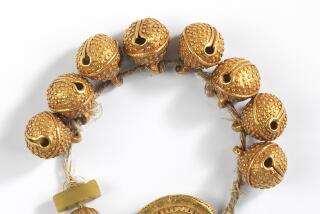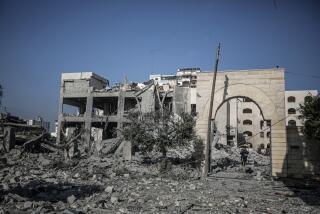The Art Collection Without a Country : Art: Touring exhibit may hold the only Kuwait Museum treasures to have survived the invasion.
- Share via
Art experts in the United States and Europe fear that one of the world’s most renowned collections of Islamic art may have been destroyed or looted by Iraqi forces occupying Kuwait.
Information about the fate of the Kuwait National Museum’s 20,000-item Dar al Athar al Islamiyyah collection is, like much of the news out of the ravaged country, sketchy at best.
Officials at the Iraqi embassies in Washington and London say they have no knowledge of the fate of the museum.
But officials of the Kuwait government and the curator of the collection say the bulk of the artworks may not have survived the Aug. 2 Iraqi takeover. The invasion, ironically, came just two weeks after a small fraction of the art collection was shipped out of Kuwait for a European and American tour that opened Aug. 6 at Leningrad’s famed Hermitage.
“Everything valuable has been taken from the museum. Everything has been looted,” said an angry Ali al Sabah, the press representative at the Kuwait Embassy in Washington,
Al Sabah said he learned of the collection’s fate from unidentified witnesses in Kuwait. Officials at the Kuwait Embassy in London could not confirm their Washington colleague’s report.
“We have read in the Arabic newspapers that his highness, the Emir of Kuwait, sent a telegram about the destruction to an Islamic conference,” said Ghada Qaddumi, curator of the Dar al Athar al Islamiyyah. “The emir said that everything was sacked and pillaged, even banks, schools, hospitals and the Dar al Athar al Islamiyyah. It makes me very, very sad, of course. I don’t want to believe it.”
Qaddumi, who studied at Harvard, was away from Kuwait on vacation when the invasion hit. She was reached in Cyprus.
The Islamic art collection, which spans 13 centuries, was amassed by Sheik Nasser Sabah al Ahmed al Sabah and his wife, Sheika Hussa, beginning 15 years ago.
Although the collection is widely admired, some in the Islamic art field believe that its fame has been, to some degree, bought. The sheik and sheika have flown in scholars from around the world to see the collection in Kuwait City and they sponsored several book-length publications written about it.
The new tour of 114 objects from the collection was being looked upon as a chance for the Kuwaitis to prove that the Dar al Athar al Islamiyyah could stand on its own merits.
The pieces now in Leningrad were selected by Esin Atil, a historian of Islamic art at the Sackler and Freer galleries, which are part of the Smithsonian Institution in Washington.
“Some of the items I would have liked to have included were just too fragile, I thought, to go out on tour for a year and a half,” said Atil. “There were others that would have been wonderful to include, but I did not think it was right to take all the best objects from the museum for that length of time.”
The pieces on tour are now the only ones known to be safe. They are scheduled to next go to the Walters Art Gallery in Baltimore in December for a two-month stay and then move on to Ft Worth, Tex., Atlanta, St. Louis and Richmond, Va. before going on to Europe. There are no plans for them to come to Los Angeles.
In the wake of the invasion, however, there is some question as to whether the exhibition will make it to the United States. After the invasion, President Bush froze all Kuwaiti assets in this country, and tour officials want to be sure the collection will not be seized by customs agents when it arrives.
Several sources said that at the time of the invasion, Sheika Hussa, who is the daughter of a former emir, was visiting her children at their schools in Europe. Sheik Nasser, who is the nephew of the current emir, was in Kuwait but managed to escape to Saudi Arabia. They are reportedly staying at their London home, awaiting the birth of their fourth child.
In a forward written to a book on the collection, Sheik Nasser said he first became interested in Islamic art as a boy when he was sent to school in Jerusalem. His Oxford-educated wife, however, was the driving force behind the collection. As a couple, they bought their first piece--a 14th-Century Mamluk enamel-worked glass bottle--in London in 1975.
The couple gathered objects from a wide variety of countries and regions, including a rare type of Safari medallion carpet from 15th-Century Iran, an 8th-Century carved niche from Syria and the oldest astrolabe in existence. In addition, they acquired impressive holdings of illuminated manuscripts, richly colored-glass pieces, ornate metal boxes, paintings, geometrically patterned ceramic tiles, jewelry and thousands of gold coins.
Sheik Nasser, who is a businessman involved with banking, real estate and trading companies, also bought a 10% interest in Christie’s art auction house.
In the early 1980s the couple hired Egyptian architect Hassan Fathi to design a museum to house the collection. But government officials proposed instead a building at the Kuwait National Museum complex. Designed in 1958 and completed in 1981, the complex comprises four buildings and a planetarium overlooking the gulf.
Sheik Nasser and Sheika Hussa agreed to make a permanent loan of their collection to the museum, and she became its director. The museum formally opened in 1983.
Although there is considerable concern about the collection in art circles, there is some optimism about its fate. There is also some doubt that the Iraqis would pillage such an important resource.
British art conservator Kirsty Norman was in Kuwait helping to oversee the packing of the objects that went to the Soviet Union.
“The last time I saw the museum was on Aug. 31,” said Norman from her home in London, “when I drove past it. It didn’t look as if it had been damaged or disturbed in any way. Everything looked quiet.
Norman was originally scheduled to leave Kuwait on Aug. 2, the day of the invasion. She did not get out until Sept. 8.
She said that she had been told by officials at the London office of Gulf International, which oversees many of the sheik’s businesses, that they, too, were in the dark about the fate of the collection.
Repeated requests to interview Gulf International officials went unanswered.
“Reports of a museum being pillaged by an invading army are not at all uncommon,” said Thomas Lentz, curator of Islamic art at the Los Angeles County Museum of Art. “The country being invaded might use these reports to help gather sympathy for its cause.
“Sometimes the reports do turn out to be true, and sometimes not.”
The majority of Islamic art scholars, while eager for news of the collection, have taken a wait-and-see attitude. “I can do nothing but worry,” said tour curator Atil.
“It would be a tragedy if a collection like this, which was carefully chosen to include all regions, all periods and all types and techniques, was gone,” Atil said. “There is no way to put a dollar amount on the collection, but that is not the important part, anyway. The loss would have to be measured in terms of culture and scholarship.”
ARTWORKS IN A STATE OF UNCERTAINTY A collection of treasured Islamic art may have been looted or destroyed in the Iraqi takeover of Kuwait. But two weeks before the invasion, a handful of works were shipped out of the country for a European and American tour. Officials at the Iraqi embassies in Washington and London maintain that they have no knowledge of the fate of the museum or specific works. The works below, however, were in the Kuwait National Museum at the time of the invasion.
More to Read
Sign up for Essential California
The most important California stories and recommendations in your inbox every morning.
You may occasionally receive promotional content from the Los Angeles Times.














